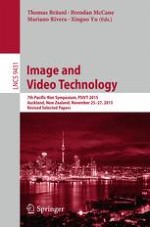This book constitutes the thoroughly refereed post-conference proceedings of the 7th Pacific Rim Symposium on Image and Video Technology, PSIVT 2015, held in Auckland, New Zealand, in November 2015.
The total of 61 revised papers was carefully reviewed and selected from 133 submissions. The papers are organized in topical sections on color and motion, image/video coding and transmission, computational photography and arts, computer vision and applications, image segmentation and classification, video surveillance, biomedical image processing and analysis, object and pattern recognition, computer vision and pattern recognition, image/video processing and analysis, and pattern recognition.
